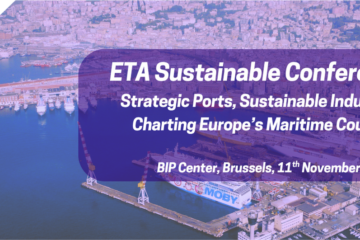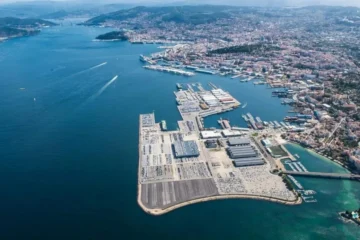The European Tugowners Association (ETA) submitted its responses to the call for evidence on the European Maritime Industrial Strategy and the European Port Strategy. These two documents are expected to be published by the end of 2025 and will establish a new policy framework for the European shipping sector.
ETA welcomes the European Commission’s initiative to develop a comprehensive European Maritime Industrial Strategy, as the shipbuilding and equipment manufacturing sector are a cornerstone of technological innovation and sustainability and a key enabler of strategic autonomy for the continent.
Thus, the ETA advocates for a European Maritime Industrial Strategy that ensures that Europe remains the leader in manufacturing state-of-the-art vessels. In the specific case of tugboats, they have for many years been manufactured in Europe, and European owners would purchase them in the continent. However, this is now on the decline due to more favourable prices in Asia. Nonetheless, most of the state-of-the-art equipment and innovation still happen in Europe. Therefore, ETA recommends targeted and comprehensive support for the shipbuilding and maritime equipment manufacturing industries. This support should include simplified pathways to both public and private funding, whether through banks, investors, or capital markets. Furthermore, ETA also calls for a regulatory environment that supports innovation and manufacturing, with the creation of frameworks that encourage calculated risk-taking in new technologies, accelerate the development and deployment of clean propulsion systems, energy-efficient designs, and smart maritime technologies, streamline smart production processes, and facilitate access to raw materials and skilled labour. Besides this, ETA recommends the development of a coherent set of incentives designed to attract shipowners, including tugowners, to place orders within Europe. In addition to this, ETA underlines the importance of the retrofitting of existing vessels, as it allows for faster decarbonisation of the fleet, extends vessel lifespans, and ensures compliance with evolving environmental standards.
Concerning the security and safety aspect of the strategy, towage should be explicitly recognised alongside military vessels, dredgers, and icebreakers as a strategic maritime asset. Towage vessels are indispensable for the safe and efficient manoeuvring of ships and also frontline responders in emergency situations, contributing to environmental protection and maritime security. Furthermore, towage services play a vital role as first responders in port emergencies, including firefighting operations, protecting both human lives and infrastructure. Thus, the European Maritime Industrial Strategy should qualify tugs as strategic assets, and thus allow tugowners to benefit from the European Defence Industry Programme and Readiness 2030.
In addition to this, and in order to keep tugboats fleets readily deployable at all times it is crucial to establish and maintain a strategic inventory of spare parts for strategic assets, including tugboats within Europe. This includes critical components such as propulsion systems, winches, control electronics, and emissions-reduction technologies.
Finally, the European Maritime Industrial Strategy should include instruments to attract young European workers to the shipbuilding and equipment manufacturing sectors, but also within the shipping sector. It should support those already in the industry by continuing to develop both traditional and technological skills, including targeted efforts to reskill and upskill the workforce are essential, not only to keep pace with the digital and green innovation.
Regarding the upcoming European Port Strategy, the ETA advocates for the adoption of a sustainability framework that balances competitiveness, environmental considerations, and social responsibility. The European Ports Strategy should explicitly recognise the ports intricate ecosystem, acknowledging the interdependence of infrastructure, operations, and services, and of towage, in particular, as it is indispensable to port safety. Thus, the Strategy must affirm the criticality of enabling and supporting port services, not only as operational necessities but as pillars of safety, security, resilience, and sustainability within the port ecosystem.
Concerning competitiveness, it is essential to establish a level playing field both within the European Union and in relation to non-European ports. Regulatory frameworks should be designed to facilitate this balance, ensuring fair conditions across the global maritime landscape. Thus, ETA urges the European Union to ensure full alignment between the EU ETS for maritime and the global regulatory framework under development at the IMO in order to avoid carbon leakage and unfair practices. ETA advocates as well for ensuring a level playing field for European ports and shipping operators and reduce the administrative burden on maritime stakeholders.
As ports are increasingly becoming actual hubs and generators of clean energy, these should be granted access to funding opportunities equivalent to those available to innovation centres across Europe. Furthermore, shipowners must be assured of a reliable and reasonably priced supply of alternative fuels to support the transition to sustainable operations and thus, European ports must be equipped with the necessary investment, infrastructure, and resources to serve as strategic energy hubs.
Complementing this, in the current context of heightened geopolitical tension, harbour tugs play a critical role in safeguarding port infrastructure and ensuring operational continuity. Their presence enhances the port’s resilience and responsiveness, making them an indispensable asset in national and regional security planning. Thus, the dual investment strategy embedded within Readiness 2030 should include harbour towage. EU funding could play a transformative role by supporting pilot projects, retrofitting existing fleets, and investing in the digitalisation and automation of towage operations.
Concerning the digital transition, the European Ports Strategy must prioritise robust cybersecurity frameworks to protect critical infrastructure and ensure business continuity. A harmonised and secure digital environment will be key to safeguarding Europe’s ports while enabling innovation and sustainable growth.
Finally, ETA agreed on a complementary common response endorsed as well by FEPORT and EMPA that asks for a EU Port Strategy that should explicitly support the development of a dedicated EU State Aid Framework for Ports, comprising both a targeted block exemption instrument and accompanying State aid guidelines. This would mirror existing frameworks in other transport sectors and provide the legal clarity and predictability the maritime sector needs. Besides, such a framework would allow Member States to provide proportionate, strategic, and EU-law compliant support to port investments that are essential to meeting Union objectives. This framework should empower Member States to provide strategic, proportionate, and legally sound support for essential port investments—such as low-emission equipment, alternative fuel infrastructure, and digitalisation—that private operators and port services providers cannot shoulder alone while staying globally competitive. Furthermore, ETA advocates that such EU State Aid Framework for Ports should also explicitly include port services such as harbour towage.


